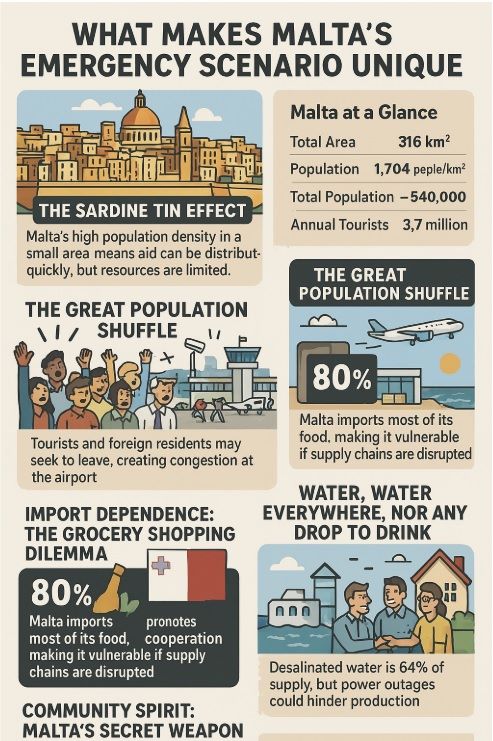| Malta Short Let: Cozy Stay in Gzira | |
|
Sliema Area Modern Designer Finished 2 Bedrooms + Games Room. First floor with Maltese Balcony Large back Terrace with swinging sofa Fully Airconditioned + Full Kitchen 3 TVs, including 65” with backlight. |
 |
|
Book Now: Google Travel | Direct (Cheapest) | Booking.com | Airbnb |
|
Ah, Malta – that tiny Mediterranean jewel where history, sunshine, and incredibly dense population converge! If an emergency were to strike this compact archipelago, the situation would be quite distinctive. Let’s take a light-hearted but informative look at what makes Malta’s emergency scenario unlike anywhere else.
The Sardine Tin Effect
With a population density of 1,704 people per km² crammed into just 316 km², Malta gives new meaning to the phrase “cozy living.” During an emergency, this actually has an upside – you’re never far from help! Aid distribution can happen remarkably quickly when the entire country is smaller than many city parks. The flip side? Everyone’s competing for the same resources, and “social distancing” becomes a fantasy faster than you can say “imqarrun il-forn” (that’s Maltese baked macaroni, by the way).
| Malta at a Glance | Numbers |
|---|---|
| Total Area | 316 km² |
| Population Density | 1,704 people/km² |
| Total Population | ~540,000 residents |
| Annual Tourists | 3.7 million |
| Distance to Sicily | 93 km |
The Great Population Shuffle
Malta’s demographics add a fascinating wrinkle to any emergency. Beyond the 480,000 Maltese nationals, you’ve got approximately:
- 60,000 foreign residents
- 105,000 third-country nationals (TNCs), with significant Filipino (12,000+) and Bangladeshi communities
- 3.7 million annual tourists, including 940,000 cruise passengers
In an emergency, this diverse mix creates what we might call the “airport stampede phenomenon.” Many TNCs and tourists would immediately want to return home, transforming Malta International Airport into something resembling a Black Friday sale at an electronics store. With aid workers and equipment trying to get in while people are trying to get out, the airport becomes a critical bottleneck.
For travelers concerned about emergencies while visiting Malta, it’s worth checking out Is Malta Safe? to understand the overall safety profile of the country.
Import Dependence: The Grocery Shopping Dilemma
Malta imports about 80% of its food, making it the equivalent of someone who never keeps food in the fridge and just orders takeout every night. When supply chains get disrupted, the cupboards get bare pretty quickly. The upside? Malta’s EU membership means it has some rather powerful friends who can send help. It’s like having wealthy relatives you can call when you’re in trouble – they might grumble, but they’ll probably help out.
As EU Commissioner Lahbib notes: “The cost of unpreparedness is simply too high.”
The Neutrality Card: A Mediterranean Switzerland
Malta’s constitutional neutrality, established in 1979, is like having a “Switzerland of the Mediterranean” status – it keeps the country out of conflicts and makes it an attractive partner for international aid. This neutrality means Malta can request assistance from various countries without political complications, creating a diplomatic advantage during crises. The island nation can maintain good relations with diverse potential aid providers, ensuring multiple channels of support remain open when needed most.
Malta’s strategic importance has been a cornerstone of its history for centuries. For more on why this matters, check out Why Is Malta Important? for historical context that shapes its modern emergency preparedness.
| Resource Dependencies | Percentage | Source |
|---|---|---|
| Imported Food | 80% | Times of Malta |
| Desalinated Water | 64% | Water Services Corporation |
| Groundwater | 30% | WSC Malta |
| Rainwater Collection | 6% | WSC Malta |
| Solar Energy | 21% | Wikipedia |
Water, Water Everywhere, Nor Any Drop to Drink
Despite being surrounded by the beautiful Mediterranean, fresh water is Malta’s perpetual challenge. The islands rely on desalination for 64% of drinking water, which is fine until the power goes out. Then that surrounding sea becomes the ultimate irony – water you can see but can’t drink. Local wells provide 30%, but they’re increasingly at risk of becoming salty due to over-extraction. Maltese cisterns, a historical water collection system, provide a mere 6% – a charming but insufficient nod to the past.
For an in-depth look at how Malta has managed water throughout its history, Water History Malta: Ancient & Modern Solutions offers fascinating insights into this crucial resource.
The Tourist Wild Card
With 3.7 million annual tourists (including 940,000 cruise passengers) visiting a country of just 540,000 residents, an emergency during peak season means the population could suddenly be significantly higher than normal. Imagine planning a dinner party for five and having fifteen people show up – that’s Malta in a crisis during tourist season. The good news? All those hotels and rental properties could serve as emergency accommodation.
For tourists caught in an emergency, having a proper Malta Packing List that includes emergency essentials can make all the difference.
Community Spirit: Malta’s Secret Weapon
The tight-knit Maltese community is legendary, especially in smaller towns like Mdina and Gozo. In an emergency, this means your neighbors aren’t just people who nod politely – they’re your support system. The Maltese tradition of helping each other out isn’t just cultural nicety; it’s an emergency response asset. When resources are stretched thin, knowing who needs what and where becomes crucial, and nobody knows a community better than those who’ve lived there for generations.
This aligns with the EU’s whole-of-society approach to crisis management, emphasizing community participation in emergency response.
Healthcare: Small but Mighty
Malta’s healthcare system punches well above its weight, ranked 5th globally by the WHO in 2000. Mater Dei Hospital, with its 906 beds and 25 operating theatres, serves as the main medical hub. During an emergency, the small size of the country means you’re never more than about 30 minutes from hospital care – try getting that guarantee in larger countries! The 112 emergency response system handles about 850 calls daily, 79% of which are fortunately non-urgent.
Travelers should consider Building Your Own Travel First Aid Kit as part of their emergency preparedness when visiting Malta.
| Emergency Assets | Details |
|---|---|
| Healthcare Ranking | 5th globally (WHO, 2000) |
| Main Hospital | Mater Dei (906 beds, 25 operating theatres) |
| Emergency Response | 112 system (850 calls daily) |
| EU Support | Access to EU Civil Protection Mechanism |
| Community Networks | Strong local ties, especially in Mdina and Gozo |
Power Precariousness
Malta’s energy situation is like a smartphone running on low battery power – adequate for now but always at risk. The Sicily interconnector provides much of the island’s electricity, but as the 2019 anchor damage incident showed, it’s vulnerable. Local power generation relies on imported fuels, and while solar power provides 21% and is growing, a major disruption could leave the islands literally in the dark. On the bright side (pun intended), Malta’s abundant sunshine means solar solutions have significant potential.
The EU Safety Net
Being an EU member means Malta can tap into the European Civil Protection Mechanism during a serious emergency. It’s like having insurance you hope never to use but are glad to have. The Emergency Response Coordination Centre can mobilize teams, equipment, and expertise from across Europe, providing a crucial safety net for the small island nation.
Natural Disasters: The Unlikely but Possible
While Malta ranks as one of the world’s safest places for natural disasters, it’s not immune. Historical earthquakes have affected the islands, and storms can cause flooding in low-lying areas. The good news is that with such a small land area, evacuation distances are minimal.
For anyone concerned about emergency vehicle incidents in Malta’s occasionally flood-prone areas, the article How to Avoid and Escape a Submerged Vehicle in Malta provides crucial information that could save lives.
In Conclusion
If emergency struck Malta tomorrow, you’d find a country with significant challenges due to its size, isolation, and resource limitations, but also remarkable strengths in its community bonds, healthcare system, and international connections. The “airport bottleneck” adds complications to an already complex scenario. The Maltese have weathered Phoenicians, Romans, Knights, Napoleon, and world wars – they’re nothing if not resilient. In true Mediterranean style, they’d likely face an emergency with a combination of pragmatism, community support, and perhaps a dash of humor – because sometimes, when the lights go out, all you can do is pour another glass of local wine and wait for morning.
To understand the historical roots of this resilience, Fortress Malta: A History of Sieges and Survival provides fascinating context on how Malta’s past has prepared it for modern emergencies.
For more information on EU preparedness initiatives that could benefit Malta during emergencies, visit: https://commission.europa.eu/topics/preparedness_en








